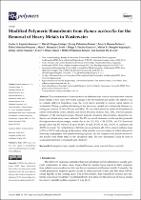Modified Polymeric Biosorbents from Rumex acetosella for the Removal of Heavy Metals in Wastewater
Fecha
2022Autor(es)
Ligarda Samanez, Carlos A.
Choque Quispe, David
Palomino Rincón, Henry
Ramos Pacheco, Betsy S.
Moscoso Moscoso, Elibet
Huamán Carrión, Mary L.
Peralta Guevara, Diego E.
Obregon Yupanqui, Mirian E.
Aroni Huamán, Jimmy
Bravo Franco, Eyner Y.
Palomino Rincón, Wilbert
De la Cruz, German
Metadatos
Mostrar el registro completo del ítemResumen
The contamination of water resources by effluents from various industries often contains
heavy metals, which cause irreversible damage to the environment and health. The objective was
to evaluate different biosorbents from the weed Rumex acetosella to remove metal cations in
wastewater. Drying, grinding and sieving of the stems was carried out to obtain the biomass, re taining the fractions of 250 to 500 µm and 500 to 750 µm, which served to obtain the biosorbents in
natura (unmodified), acidic, alkaline, and mixed. Proximal analysis, PZC, TOC, removal capacity,
influence of pH, functional groups, thermal analysis, structural characteristics, adsorption iso therms, and kinetic study were evaluated. The 250 µm mixed treatment was the one that presented
the highest removal percentages, mainly due to the OH, NH, -C-H, COOH, and C-O functional
groups achieving the removal of up to 96.14% of lead, 36.30% of zinc, 34.10% of cadmium and
32.50% of arsenic. For contact times of 120 min and an optimum pH of 5.0, a loss of cellulose mass
of 59% at 328 °C and a change in the surface of the material were also observed, which allowed for
obtaining a topography with greater chelating capacity, and the Langmuir and pseudo-second or der models were better fitted to the adsorption data. The new biosorbents could be used in
wastewater treatment economically and efficiently.
Colecciones
El ítem tiene asociados los siguientes ficheros de licencia:

